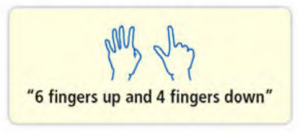Hidden Fingers
Purpose
To build fluency with pairs of numbers that equal 10.
Materials
None
Overview
 Show the back of your hands to the class, put up a few fingers, and ask how many fingers are up and how many are down. If children are unsure, suggest that they copy what you are doing with their own hands. Play this for several rounds.
Show the back of your hands to the class, put up a few fingers, and ask how many fingers are up and how many are down. If children are unsure, suggest that they copy what you are doing with their own hands. Play this for several rounds.
Once children show confidence, vary the game by finding number pairs that equal 10 (with no fingers). Children eventually move to finding pairs to 20.
About the sequence
In Part 1, the game is played using 10 fingers. Part 2 is done without using fingers. The extension moves find pairs that are equal to 20.
Part 1
We are going to play Hidden Fingers. I’m going to show you some fingers and you tell me how many are up and how many are down.
Examples:
- 6 fingers up, 4 fingers down
- 7 fingers up, 3 fingers down
- 2 fingers up, 8 fingers down
- 5 fingers up, 5 fingers down
- 8 fingers up, 2 fingers down
If children need more practice or are enjoying their mastery, repeat. If children are ready to move on, go to Part 2.
Part 2
Let’s play the game again, but this time without using fingers. I’ll say a number, you tell me the number pair that equals 10.
Examples:
- 8 (2)
- 7 (3)
- 3 (7)
- 4 (6)
- 5 (5)
- 6 (4)
- 1 (9)
- 2 (8)
- 9 (1)
- 0 (10)
If children need more practice, repeat. Or, when children seem excited for a new challenge, move to the extension.
Extension
Let’s play the game again, but this time we will find pairs of numbers that equal 20.
Examples:
- 18 (2)
- 17 (3)
- 3 (17)
- 4 (16)
- 15 (5)
- 16 (4)
- 11 (9)
- 2 (18)
- 9 (11)
- 0 (20)

This work is licensed under a
Creative Commons Attribution-NonCommercial-NoDerivatives 4.0 International License.
